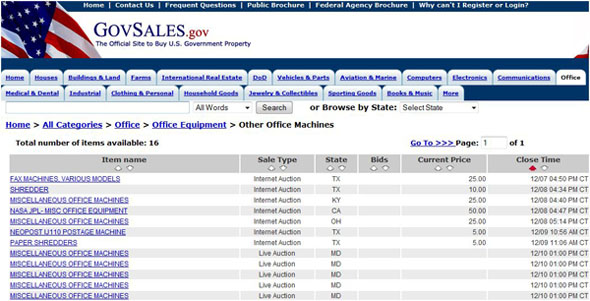Going, Going, Gone!
by Andrew Boyd
Today, going, going, gone! The University of Houston's College of Engineering presents this series about the machines that make our civilization run, and the people whose ingenuity created them.
Mention an auction and we imagine a room filled with people, an auctioneer calling out ever higher prices until bidding stops. The highest bidder wins, paying his last bid. But in reality there are many, many ways to hold an auction. And economists have devoted a lot of effort to studying them.
The auctions we usually think of, with prices moving upward, are called English auctions. With Dutch auctions, the auctioneer calls out the bids, starting high and lowering the price. Ten dollars. Nine dollars. Eight dollars. When the first potential buyer steps in and says, "I'll take it," the auction's over. Dutch auctions take their name from the way flowers are sold in Holland. Cut flowers perish, and Dutch auctions speed things along.

Dutch auctions appear in all sorts of places. Variations on the Dutch auction are sometimes used to sell stock at initial public offerings. The most famous company to do so was Google. Another variation on the Dutch auction is used to sell auction rate securities — the bonds that caused so much trouble during the 2008 financial meltdown. There was nothing wrong with the auction process. Companies simply stopped showing up to make bids.
What may be the strangest type of auction is the Vickrey auction. In Vickrey auctions, bidders offer sealed bids. The highest bidder wins, but pays the price of the second highest bidder. Sounds crazy. Why on earth would a seller accept less money than the highest bid?
It starts with bidders knowing they're in a Vickrey auction. It causes them to change how they bid. In a Vickrey auction, it's always best to bid what you feel an item is worth; no more, no less. That's not true of all types of auctions, where gamesmanship can very much come into play. The argument that this is the right strategy is so compelling it helped William Vickrey win the 1996 Nobel Prize in economics. And the argument isn't hard to follow. The proxy method used by eBay is a disguised form of Vickrey auction.
But my favorite auction comes from another economist, Martin Shubik. It works like the common English auction, with increasing bids and the highest bidder winning. The only difference is that both the highest and the second highest bidder pay their last bid: one winner, two payers. That's just the way it works. Try this experiment at your next holiday gathering. Take out a dollar bill and put it up for auction, explaining the one winner, two payer rule. Open bidding at one cent. Then wait to see what happens. You'll see that ingenuity comes in many forms.
I'm Andy Boyd at the University of Houston, where we're interested in the way inventive minds work.
Notes and references:
V. Krisna. Auction Theory. Burlington, Massachusetts: Academic Press, 2009.
The method of Martin Shubik is less for use in auctions than as a game describing the rationale for escalation. Further discussion of the Dollar Auction Game can be found at Dollar Auction. From the Wikipedia web site: https://en.wikipedia.org/wiki/Dollar_auction. Accessed December 1, 2009.
The original article describing the game is:
M. Shubik. 1971. "The dollar auction game: A paradox in non-cooperative behavior." Journal of Conflict Resolution, 15(1), pp. 109-110.
The picture of the flowers at auction is from Wikimedia Commons. The picture of the list of auction items is from the web site www.usa.gov, now unavailable.
Proof that in a Vickrey auction, it's always in a bidder's best interest to bid his true value for the item being auctioned rather than try to game the system:
We begin by laying out some assumptions and definitions from which to build our argument. Let V represent the value of an item being auctioned for a bidder we'll call Joe. In more specific economic terms, we define V as the maximum amount Joe would be willing to pay for the item. Under this definition, Joe would feel better off not purchasing the item than paying more than V; and if he can pay less than V, he feels better off purchasing the item than not purchasing it.
With these assumptions and definitions in hand, we consider four possible cases where Joe bids some value other than V, and show that in each case, no matter what the outcome of the auction, Joe would have been at least as well off by bidding V. (For simplicity in all of the following arguments, we assume that none of the values V, J, B, and A are equal.)
Situation 1: Joe wins the auction with bid J other than V (Joe submits the highest bid).
Case 1a: The second highest bid B is less than V. According to the rules of the Vickrey auction, as winner Joe pays the amount B. But if he'd bid V instead of J, he still would have won and still would have paid B. The outcome is unchanged.
Case 1b: The second highest bid B is more than V. Since Joe is winner, his bid J is more than B, which in turn is more than V. Since Joe is paying more than his value V, he would have been better off bidding V and losing.
Situation 2: Joe loses the auction with some bid J other than V (the highest bid A is greater than J).
Case 2a: The highest bid A is less than V. If Joe had bid V instead of J, then Joe would have won, and would have paid the price A which is less than V, making him better off than with the present outcome.
Case 2b: The highest bid A is more than V. If Joe had bid V, he still would have lost. The outcome is unchanged.
Since the four cases cover all possible outcomes, the proof is complete.
